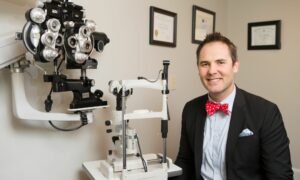By Brian Chou, OD,  FAAO
FAAO
For more than a decade, I’ve had the privilege of consulting to several ophthalmic companies, from tiny start-ups to big established corporations. I believe my greatest value as a consultant is insight from clinical practice–the frontline of patient interaction. Perhaps not often enough, I’m asked by company representatives what they can do to support practitioners. I like that question, because it demonstrates awareness of how their company’s success hinges on supporting practitioners’ care for their patients. That’s more endearing than the patronizing attitude of, “Doctor, let me tell YOU what your patients need.” To be fair, there are times when the latter approach is justified. But our industry is strongest when the manufacturers and practitioners work together harmoniously toward meeting what our patients need and want.
With the contact lens industry, I lament the direction we’re headed. Perhaps to your surprise, I’m not referring to the commoditization of lenses and eroding profitability of the sale of contact lenses. I’m actually OK with that since it should be countervailed by increased profitability of the contact lens services. The problem is that the cost-shifting hasn’t happened to the extent it should. I believe the contact lens manufacturers are unwittingly part of the problem.
I don’t profess to have all the answers, but here are some concepts which could help the manufacturers better align with practitioners:
• Recognize that the term “contact lens fitting,” although ingrained in industry parlance, is a horrible description of what practitioners actually do. Consumers think that they are qualified to perform a “fitting” themselves, like trying on underwear to make sure it’s not too loose or too tight. In reality, the practitioner is expending greater time and expertise optimizing vision by over-refracting and compensating for lens rotation, and evaluating the baseline ocular health and response to contact lens wear. The practitioner is also assessing and rendering instruction on care and solution use. The aforementioned services are disconnected from the consumer concept of “fitting.” For that reason, I argue that “contact lens evaluation” and “contact lens prescribing” are better suited terms which should replace “contact lens fitting” in consumer marketing from brochures, package inserts, web site information, and so on. Supporting the right descriptive terminology enhances the practitioner’s ability to appropriately charge for what they’re actually doing, rather than leading patients to question why their practitioner charged a garbage “fitting fee” when they walked out the door with the same contact lens prescription they came in with.
• Forget about making contact lenses “easy-to-prescribe” – make them more successful for patients. When a practitioner complains that it takes too long to prescribe a specific contact lens, either the practitioner is not charging enough for the service, or the prescribed contact lens is not successful enough to warrant the chair time. Put it this way: if there was a contact lens that was 100 percent successful for vision, comfort, handling, and was relatively inexpensive, the practitioner would want this lens to be time-consuming to prescribe because patients would gladly pay for the service!
• Stop promoting free “sample” or “trial” contact lenses to consumers in a manner where practitioners are thrown under the bus by making us deliver the bad news that professional services and fees are required. Instead, educate consumers that that it is desirable to seek the obligatory professional services for contact lens wear and that diagnostic lenses are used by doctors to generate a valid contact lens prescription.
• Expand contact lens power parameters inward, not outward. Why keep trying to go after the esoteric “extended range” parameters, like -2.75 diopter cylinder toric lenses? There is a much larger market for -0.37 DC toric contact lenses. For a patient with a spectacle Rx of -1.00-0.50X020, a spherical lens would not optimize vision, yet a toric lens correcting -0.75X020 would induce against-the-rule astigmatism. Having these low-cylinder toric lenses would support practitioners by heightening the value of contact lens services for identifying and treating low astigmatism, a very large market.
I’d like bold and unified leadership by the contact lens manufacturers, with cohesive support from the vision benefit industry, to elevate the value of contact lens services. Contact lenses, like prescription drugs, are now perceived by many consumers to be like retail non-prescription goods, thanks to internet distributors and direct-to-consumer advertising. While there is no going back with this product perception, I believe there should be dignity and value of the professional services for prescribing them. This is where the manufacturers have the capability for compelling influence. I believe that practitioners would notice and reciprocate their support to the contact lens manufacturers elevating the value of their services.
Today, optometrists collectively undercharge for our services and overcharge for products. While market dynamics have created what I believe are fairer consumer prices for ophthalmic products, the contact lens manufacturers are in a unique position to catalyze a proportionate increase in professional service fees to a fair level.
How do you feel about the service contact lens manufacturers provide to ODs and our patients? Any requests of your own for changes to the industry?
Brian Chou, OD, FAAO, is a partner with EyeLux Optometry in San Diego, Calif. To contact him: chou@refractivesource.com.

























